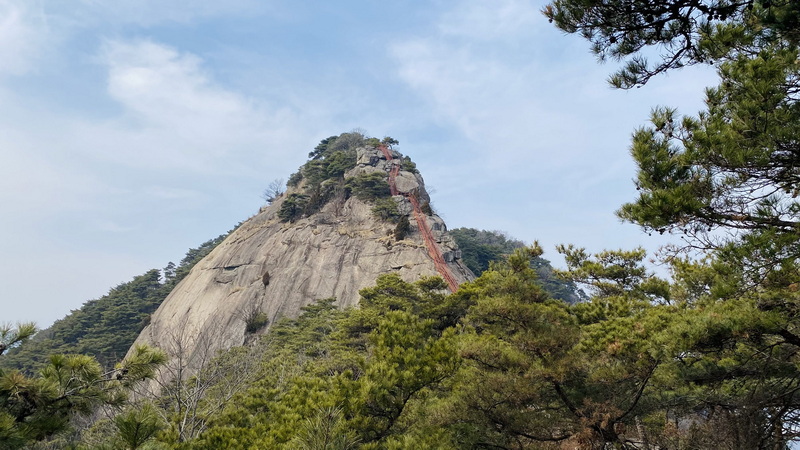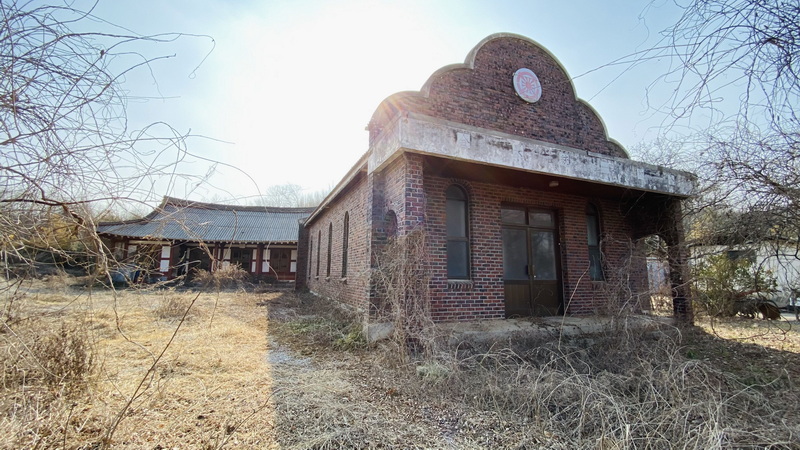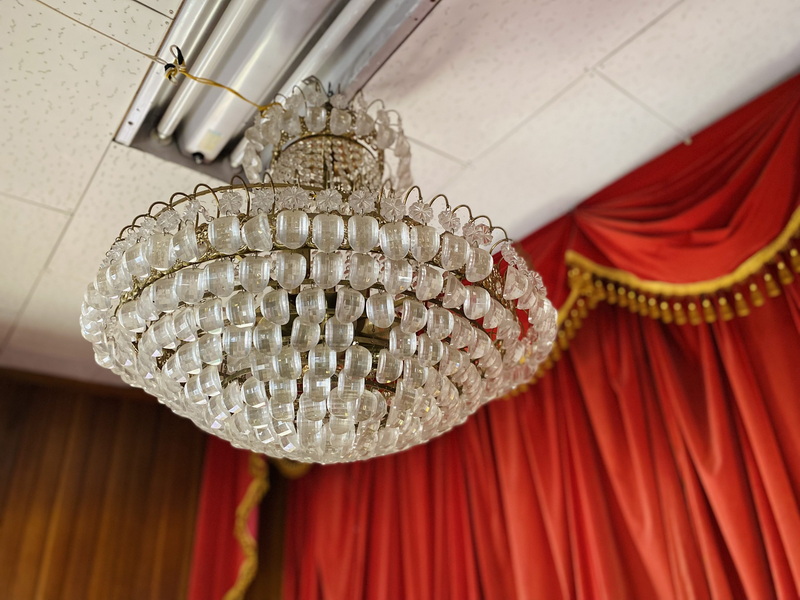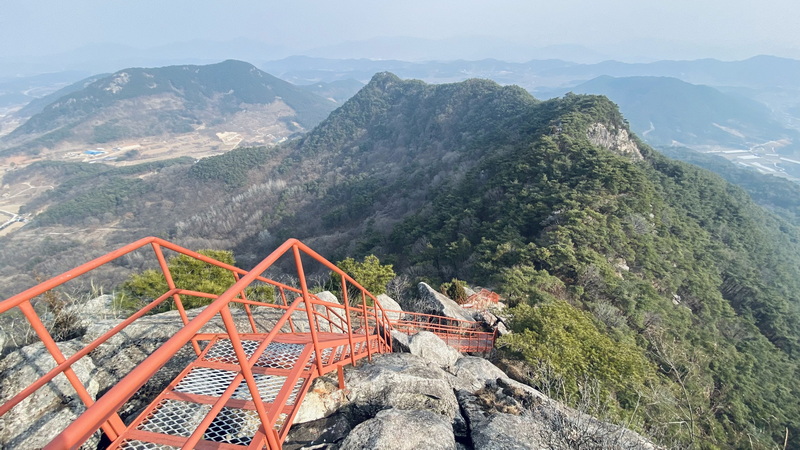Sunchang’s Ami-san and Moonie Church
By Isaiah Winters
Sunchang County’s been on a roll lately in terms of tourism promotion. The county boasts a pair of suspension bridges at Gangcheon-san and Chaegye-san, plus the new zigzagging boardwalk up Yonggwol-san. The county’s tourism crown jewel is probably its hanok-inspired Gochujang Village, adjacent to which is the new Sunchang Fermentation Theme Park (순창발효테마파크), which is about the most Jeolla pair of tourism facilities imaginable.
The latter two sites are backdropped by Ami-san, a boulder-studded promontory fixed with vertigo-inducing staircases that somehow nobody ever seems to notice. I hiked its 515-meter summit on a whim recently and loved it, returning just a week later with the missus so we could gasp our way to the top together in full StairMaster misery. (As they say, misery loves company.) Down in one of Ami-san’s bucolic valleys is an even less-noticed haunt – an abandoned chapel and hanok affiliated with the Unification Church, otherwise known as the “Moonies.” As this is a “Lost” article, we’ll of course hyperfocus on these disregarded sites, which I’m sure county officials won’t appreciate.

Ami-san is somehow both Sunchang County’s most visible mountain and its tourism black sheep. It’s located right along Highway 12, so if you’ve ever gone that route from Gwangju to Jiri-san, or even further on to Daegu, you’ve surely seen it. It’s even got the Gangcheon-san Rest Stop (강천산 휴게소) right at its base, which should make Ami-san the county’s most easily accessible tourist destination – except it isn’t. On our way down the mountain, the missus and I had a rough time fighting through thorn bushes and other undergrowth to reach the rest stop, only to have the providential staircase we stumbled upon roped off at the bottom. Rather than encourage hikers to park at the rest stop, grab supplies for the hike, and then return to the rest stop tired, thirsty, and hungry after an excellent trek, the owners seem to want visitors to have no connection to the mountain whatsoever. Hell, they didn’t even use the mountain’s name for the rest stop itself.
A further irony here is that the rest stop is decked out in new vinyl window decals advertising the county’s many excellent tourist sites – basically everything mentioned in the opening paragraph of this article. Among those many decals, Ami-san is nowhere to be found. What we found firsthand on the mountain was quite impressive, however. On our trip, we spotted a half-dozen giant vultures circling the valley below in search of roadkill and other carrion. While hiking in Honam, I’ve seen giant vultures fly solo or in pairs many times, but never six at a time. This suggests there’s a lot of carcasses to feed on in Sunchang County, for whatever macabre reason. But these giant birds don’t stay for long, as they only fly down from Mongolia and Manchuria to winter in Korea’s warmer climes before returning sometime in spring. The Californian in me always finds them riveting, having been instilled with a reverence for the critically endangered California condor since elementary school.

Another temporary feature of the mountain which endears me to it is a stout, old man I call sanshin (산신, mountain spirit). He’s been up at the top both times I’ve hiked the mountain this spring, sitting alone in a small observation booth. From there, he keeps an eye on the valleys below for any fires that flare up, often due to farmers incinerating their garbage. When a fire does occur, he radios into the fire department and keeps them updated on the situation. This he does as a retirement side gig during the driest parts of the year when forest fires are most likely. He collects minimum wage for his efforts, which amounts to about two million won per month. It’s a far cry from the salary he used to pull at the Ministry of Justice, but as he loves hiking and has property inherited from his parents down in the valley below, it’s a pretty convenient side hustle that keeps him healthy. What’s more, he maintains a social life in this way by talking the ear off anyone who reaches the peak, which is why I know so much about him.
Descending from the mountain for the remainder of this article, we’ll finish in a crescent-shaped village that looks out over rice paddy grids in the shadow of Ami-san. This village is home to a unique pair of religious structures: an abandoned chapel and hanok associated with the “Moonies.” The chapel façade is made of an odd, billowing brick style that reminds me of a cloud – the centerpiece of which is the Unification Church’s controversial logo: essentially a Japanese “rising sun” flag encircled in red. The church’s late leader, Moon Sun Myung, had an interesting upbringing in what’s now North Korea, which he left to study electrical engineering in Japan in 1941. He returned to Korea in 1943 and later wound up imprisoned in a North Korean labor camp, presumably for his involvement with Christianity. UN soldiers would go on to liberate the camp in 1950, after which Moon made his way to South Korea, where he began his teachings – that is, if Wikipedia is to be believed. What’s for certain is that the Unification Church’s “Moonie” nickname is derived from its leader’s surname. Oh, and they hold mass weddings that marry off thousands of couples whose marriages are arranged through the church. If you’re curious to know more, YouTube’s got everything in excruciatingly awkward detail.

The chapel doesn’t contain much of interest anymore, though the stage is worth a mention. It’s still got a hefty, wooden donation box (헌금함), a bulky pulpit bearing the Greek alpha and omega symbols, plus a gaudy chandelier – all framed by a plush, gold-trimmed velvet curtain. Enveloped in such kitschy elegance, it’s not hard to imagine the days when church leaders used to break out the elaborate robes and glitzy crowns often seen in “Moonie” religious ceremonies. Moving on to the large hanok out back, the first thing you’ll notice is the porch, which is strewn with books on Korean history and philosophy, some of which have been overtaken by vines creeping across the floorboards. The hanok is impressive for both its size and condition: It’s got enough headspace inside for a large attic above the main room held up by thick, sturdy beams that appear to still be in great shape. Adorning nearly every wall is a different picture of Mr. Moon and his wife, known as the church’s “true parents” (참부모). The best find inside is a scrapbook featuring news clippings and photos from the church’s more notable events, often those held abroad. If you’re interested in seeing the chapel and hanok in detail, you can visit the Lost in Honam YouTube channel for more.
So, there you have it, readers. Sunchang County has many unique sites for visitors that aren’t always worthy of a tourism billboard or rest stop decal. Have fun finding more of your own.
The Author
Hailing from Chino, California, Isaiah Winters is a pixel-stained wretch who loves writing about Gwangju and Honam, warts and all. He’s grateful to have had the opportunity to write for the Gwangju News all these years. More of his unique finds can be seen on Instagram @d.p.r.kwangju and YouTube at Lost in Honam.







